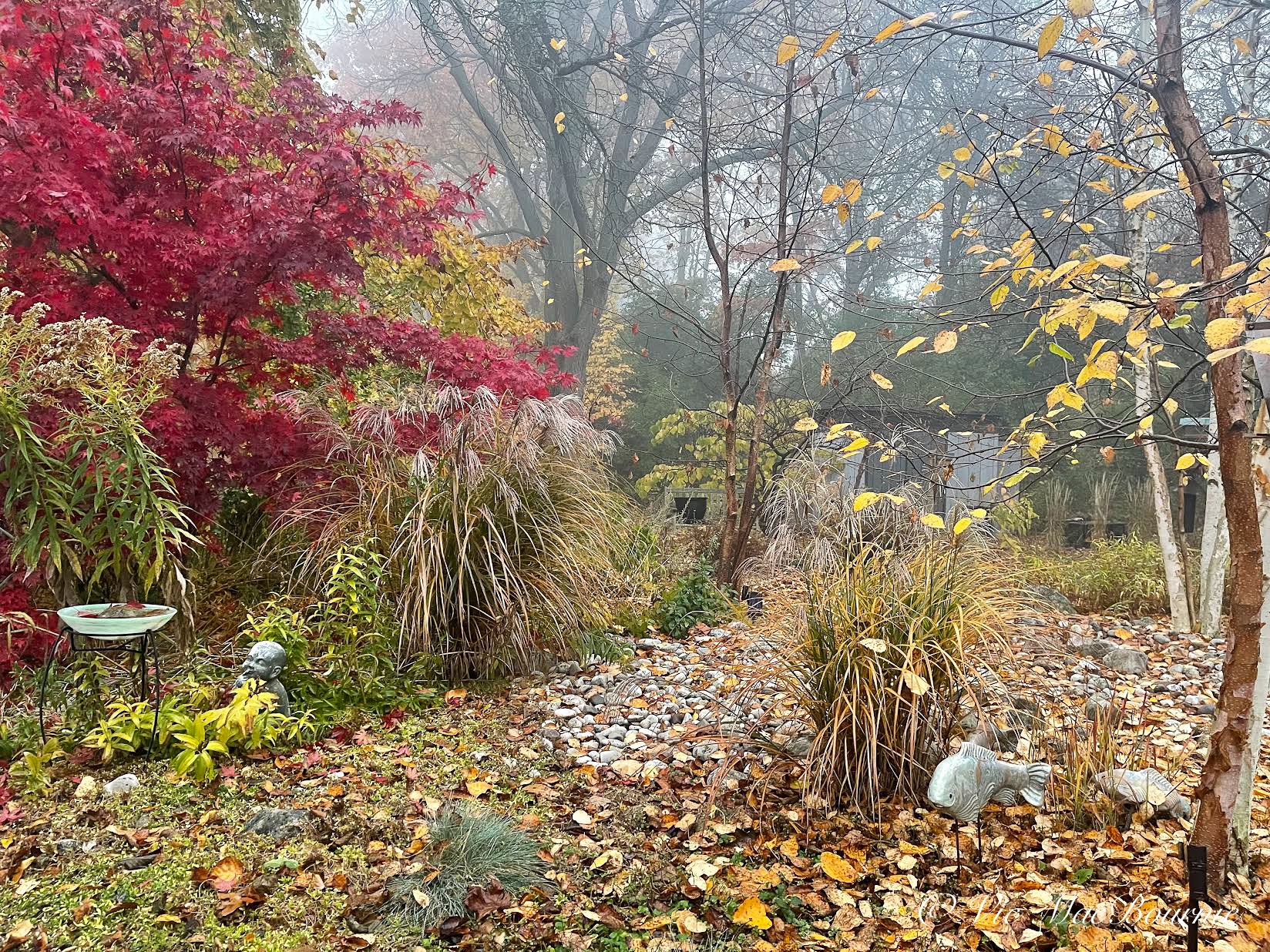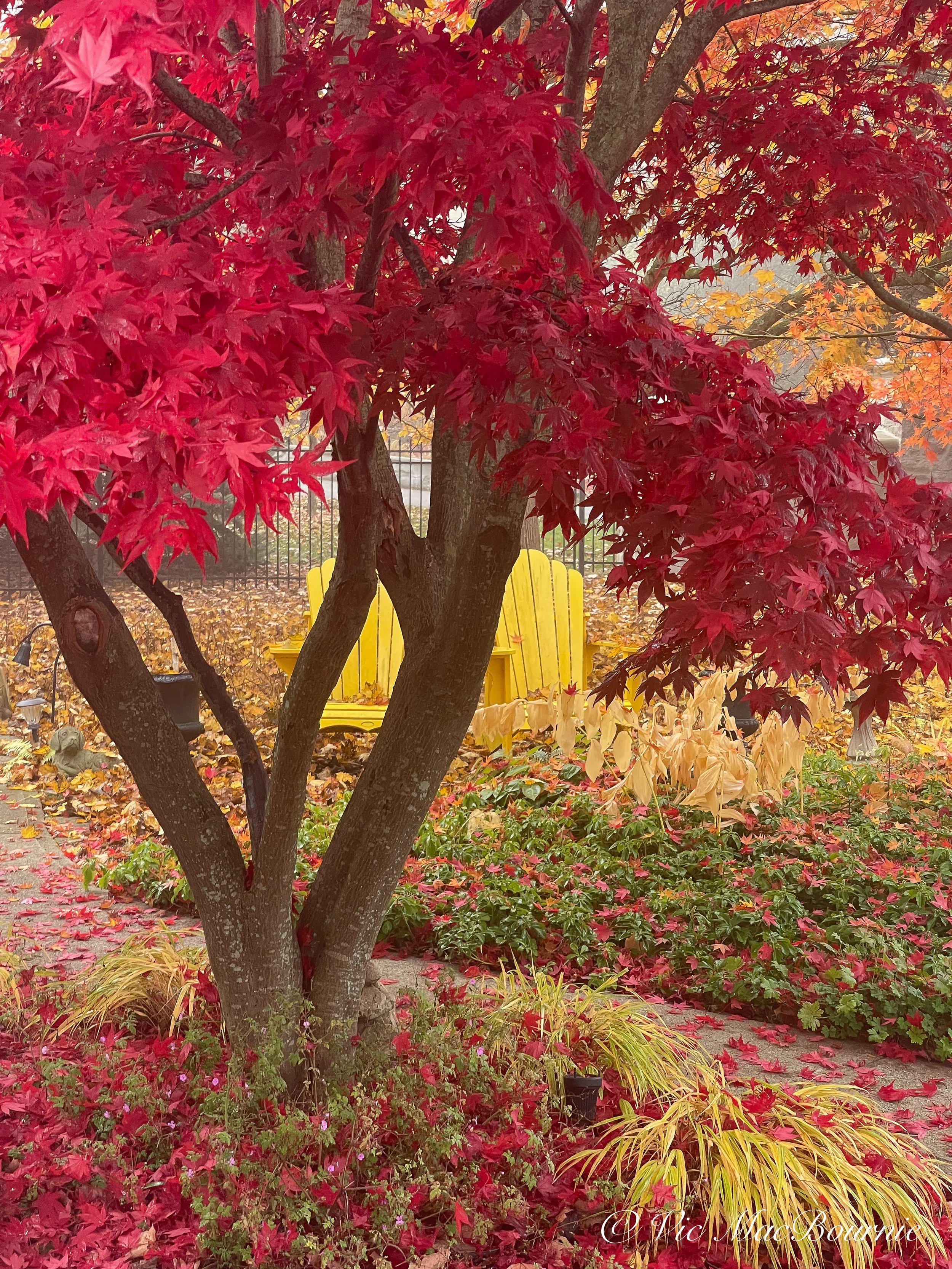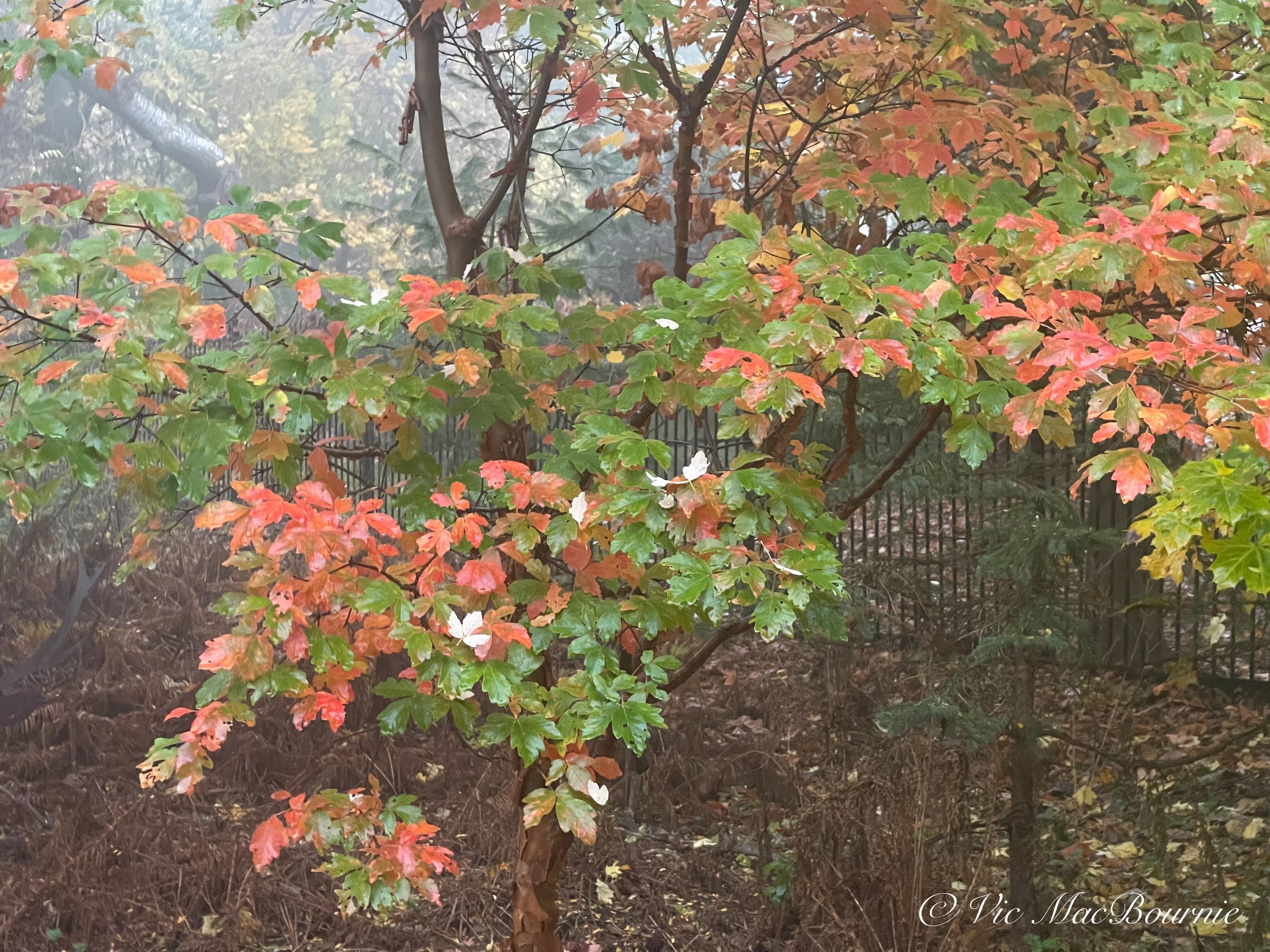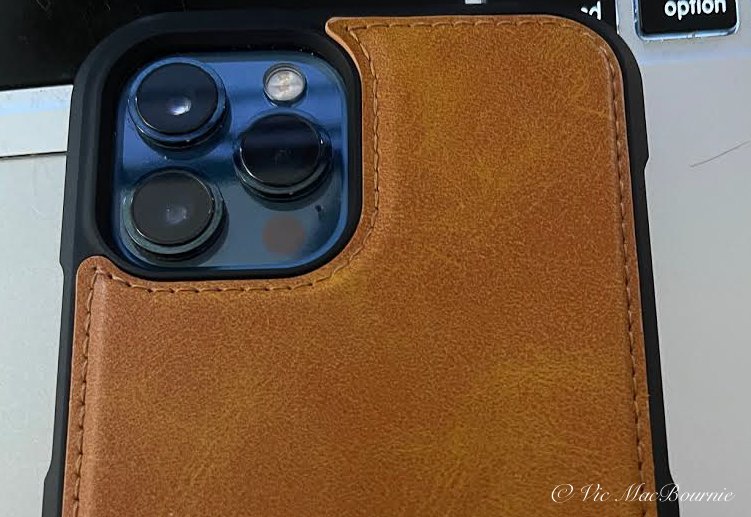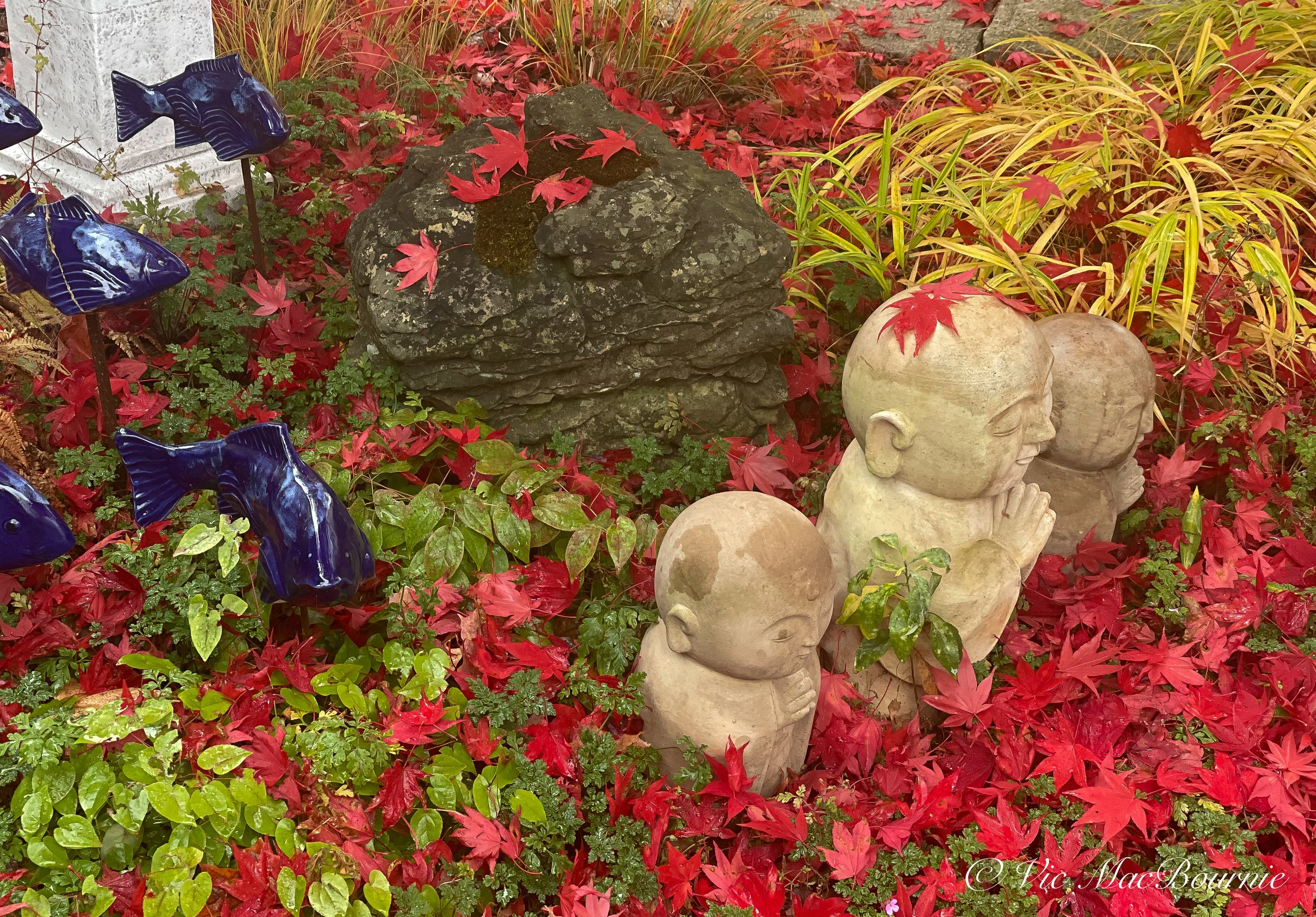Iphone camera captures Woodland garden in stunning fall colours
Take advantage of ideal conditions to capture your front and back gardens
Can modern cameras on the iphone or other smart phones capture the subtle details of fall colours in the garden?
If a recent morning outing in the garden with nothing but my iphone is any indication of the performance of the three camera lenses on the apple iphone, I think the answer is a resounding yes. The images captured on the apple iphone 12 pro max turned out beautifully on an early morning with a lovely fog hanging in the air and wet leaves either still clinging to the trees or turning the ground into a magnificent carpet of colour.
The colours produced by the apple iphone are subtle and delicate where they cut through the fog and vibrant when the camera was turned on the crimson red of the fallen Japanese Maple leaves. Little to no post processing was needed to get these results.
Quite frankly, I was astonished just how good the images came out with little to no effort on my part. Thanks to the shake resistance capabilities built into the iphone camera, I was able to take all of these images handheld without the need of a tripod. If there is any criticism, it would be that the images are too sharp and take on a digital look, especially if the images are cropped.
Would a real camera (either a DSLR or high-end compact point and shoot) have captured better images? Maybe – well, probably yes – but I had my new iphone handy and it comes with three lenses – an extreme wide angle, a standard, and a portrait lens – so I was confident I could capture everything I needed with the iphone. Besides, I decided I needed to put the smartphone camera to the test to know that I could trust it if I ever really needed it to capture an important image. From what I had already seen, I was confident it could get the job done.
And boy, was I right.
Maybe it was the outstanding conditions with the early morning fog and wet leaves that helped bring out the beauty in the scenes, but the ease and convenience of using the lenses on the iphone meant I could move quickly to capture the scenes before the light changed.
For more images taken on the apple iphone 12 pro max, go to my Gallery of Images and click on the image at the bottom.
With a press of the icon on the phone I could easily go from extreme wide angle to normal. And, by tapping into the normal lens’s zoom range, it was simple to move in closer when necessary.
Five tips to get the most out of your iphone camera and lenses
Experiment. Don’t be afraid to use all three lenses to get different views of the same or similiar scenes. You can always edit them later and pick your favourites to put up on social media.
Move in close to flowers, insects or colourful leaves to tell a more complete story about your garden at that moment. The iphone’s close focusing capabilities are excellent and the optical shake reduction system will help you get sharphand held images.
Try different angles. Holding the iphone up above your subject and shooting down on it, or getting low and shooting up will give you different perspective of similar scenes. Try to hold the camera straight (not pointing at odd angles) to keep the proper perspective in the images.
In portrait mode there are a number of different lighting effects that you could try to add more drama to your images whether they are an actual portrait or a garden scene.
The iphone is a very smart piece of technology that uses artificial intelligence to create the type of images it thinks will look best. Experiment with the tools, especially the touch screen focusing and exposure adjustments that are available. Focus specifically in an area you want the camera to focus on by touching the screen. A square will appear to tell you that is where the camera is focused. At that time you can also adjust the exposure by moving the small sun icon up for a lighter image and down to darken it.
iphone 12 pro max camera specifications
I would prefer not get into the fine details of the iphone’s specifications, since there are a number of technical sites that focus on such details. However, some basic information might help readers better understand the camera’s capabilities.
The iphone pro max has three lenses on the back of phone. While looking at the phone, the user sees three settings – 0.5 (representative of a 13mm f/2.4 lens in 35mm lingo), 1X (26mm f/1.6 in 35mm equivalency) and 2.5X (65mm f/2.2 equivalent in 35mm). The iPhone Pro Max features a 5x optical zoom range and a much larger digital zoom up to 12x. Using the digital zoom at its extreme will likely leave you with images that will be unsatisfactory in most instances.
For more on the apple iphone line including comparisons between the various models’ camera features, go to the apple iphone site.
Although at the time of writing this post, the iphone 12 pro max is by no means the latest iteration of Apple’s iphone line – that would be the iphone 14 Pro. That iphone comes with the latest Pro camera system sporting a 48MP camera sensor with ultra wide and telephoto lenses, something they call a Photonic Engine for incredible detail and True Depth colour. The iphone14 is a step up from the dual-camera 12MP camera system in the iphone 13, but not that much of a leap from the iphone 12 pro max that I am now using.
Both the iphone 14 and the 12 pro max offer the three camera lens system but the 14 boasts a massive 48MP sensor while the 12 pro max comes in with a 12MP sensor. The 14 has a 6X optical zoom range, while the older iphone 12 model has a 5X optical zoom range. Both have 6.7-inch Super Retina XDR display screens.
So, unless you are planning to create poster-size images of your photographs, or need to seriously crop your images to get in closer to your subjects, there really is not a huge difference between the latest iphone and my trusty iphone 12 pro max. The larger sensor would also improve noise in the image, especially in the evening when the light is low.
In garden photography, there would be little need to want to upgrade to the newer iphone and camera unless you are using it to photograph birds or small mammals. Images taken from afar with the iphone 14 could take a much more severe crop to get in close to the subject (a bird for instance) than the smaller sensor on the iphone 12 would allow. In that case, however, it’s probably wise to use a dedicated camera and telephoto lens.
A slight mist or fog is the ideal time for garden photography
There is no question that the soft fog and misty conditions created the ideal atmosphere to show off the capabilities of the iphone 12 pro max. In bright sunny conditions, the images would not have anywhere near the impact that the right atmospheric conditions can bring to a scene.
Using these opportunities to get out in the garden can make a huge difference to your photographic success. The annoying backgrounds are either softened or disappear completely in the fog. The colours are muted and the tree trunks take on the look of dark skeletons against the white background of the sky. The lighting is even and even the darkest areas of the garden benefit from the soft light in the scenes.
When the fog rolls in, it can be a magical time.
Even if you are busy or need to get out the door to get to work, try to take a moment to grab a camera, or your cell phone, and capture your garden in its best light. You won’t get many of these special opportunities – especially in fall when the colours are at their peak – so don’t miss the opportunity.
For more on the apple iphone line including comparisons between the various models’ camera features, go to the apple iphone site.

